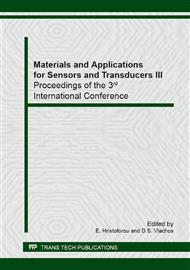p.1
p.7
p.11
p.15
p.19
p.23
p.27
p.31
The Fabrication and Characterization of Niobium-Doped Titania Ceramic
Abstract:
Transparent conductive oxide (TCO) films have been widely used in various optoelectronic devices as the transparent conductive electrode. Niobium-doped titania (TNO) films were recently found to be highly transparent and conductive and thus could be a potential substitute for tin-doped indium oxide (ITO) films. For the preparation of TCO films, magnetron sputtering is a versatile method due to its high deposition rate, feasibility for large-area deposition, and other advantages. The quality of the sputtering target has been found to obviously affect the performances of the films. However, the fabrication and the properties of sputtering targets have rarely been examined. Thus, the purpose of this study was to prepare and characterize TNO ceramic for application as a TNO sputtering target. Sub-micrometer TiO2 and Nb2O5 powders were used to formulate the ceramic slurry with a dispersant and a binder. The ceramic slurry was then spray-dried to form spray-dried granules. TNO green compact was produced by uniaxial compacting of the spray-dried granules. After 1200°C sintering in air, the sintered density of the TNO ceramic was 100%. The grain size was only 2.8μm. Moreover, after 1200°C sintering, the TNO ceramic was fully rutile phase, as verified by XRD. Nb2O5 diffused and dissolved into the titania. Furthermore, the dopant of Nb greatly decreased the resistivity of titania from 108Ωcm to 90Ωcm, though the resistivities of the TNO ceramics were higher than those of TNO films reported in the literature.
Info:
Periodical:
Pages:
11-14
Citation:
Online since:
April 2014
Authors:
Keywords:
Price:
Сopyright:
© 2014 Trans Tech Publications Ltd. All Rights Reserved
Share:
Citation:


